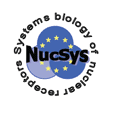 |
|
|||||
|
NucSys
Consortium Thematic Areas Training and Transfer of Knowledge (ToK)
|
Thematic Areas PPAR biology PPARa, d and g may be the nutrient-reponsive NR superfamily members with the largest impact on human diseases. Affymetrix chip screening of gene expression in a large panel of fasted and regular diet-fed, ligand-treated and untreated PPARa KO and normal mice performed by WAG will provide a complete list of PPARa responding genes in mouse liver (milestone 1.1). These transcriptomics data will be used for a first round of systems biology modelling by VUA and for in silico screening of the promoter regions of all of these genes in the mouse genome (and their orthologues in the human genome) for PPAR REs by KUO (milestone 1.2). The list of candidate genes will be distributed in the Consortium and testing of the genes (also as potential PPARd and g responding genes) in response to PPAR ligands derived from human diet (or their synthetic counterparts) will be performed in skin (Unilever), bone (ERA, KUL), colon cancer (IIB, WIE), breast cancer (SGUL) and prostate cancer (BIR, BXL) cells as well in different KO mice (MAX) by transcriptomic and proteomic techniques (milestone 1.3). The data will be reported back to VUA and will be used for a combination of analytic and synthetic modelling of PPAR signaling in human tissues. Most responsive and representative genes will be investigated in more detail by WAG, KUO and BIR using chromatin immunoprecipitation (ChIP) assays and related technologies (milestone 1.4). Moreover, the task of metabolomic profiling of selected human tissues in response to PPAR ligands will be distributed between OUL, BIR and UniS (milestone 1.5). Physiomic studies will use siRNA knockdown used for key genes studies in the primary model tissues (Unilever, ERA, BXL, MAX) and cells under study (milestone 1.6). Again, data will be reported back to VUA to refine models, which will now be combined with established understanding and the model will be brought as close as possible to a silicon cell (i.e. replica) qualification (milestone 1.7). VUA will attempt to connect the above model to measured physiomics (milestone 1.8). Eventually tissue-specific KO mice will be generated but it is probably not feasible within the time frame of the proposed project.
Genotypic variation in NR function The paradigm of the mechanism of lactose tolerance has demonstrated the key impact of regulatory single nucleotide polymorphisms (SNPs) on diet-genome interactions. KUO will perform in silico screening of all human SNPs that are available in the dbSNP database and other sources and will select those that affect a critical position in a putative NR REs (approximately 1 in 400 SNPs). From these more than 10,000 candidate sites, those that are in distance of less than 2,000 bp to the transcription start site of a gene will be selected and sorted by NR superfamily members that may bind to them (milestone 2.1). Putative binding sites (e.g. PXR, CAR, PPAR, VDR and steroid receptors will be inspected further by OUL, UniS, ERA and SGUL (milestone 2.2), leading to functional binding site studies by KUL and KUO using ChIP assays, qRT-PCR and other transcriptomic and proteomic techniques (milestone 2.3). All data will be collected and reported to VUA for integration to their in silicon cell model (milestone 2.4). Moreover, candidate NR target genes that are affected in their expression by regulatory SNPs will be tested in human skin (Unilever), bone (ERA, KUL), colon cancer (IIB, WIE), breast cancer (SGUL) and prostate cancer (BIR, BXL) cells by transcriptomic and proteomic techniques (milestone 2.5). A short list of interesting SNPs will be tested in samples collected from different human populations, such as breast cancer patients (SGUL, 600 individuals), the Rotterdam cohort (ERA, 8,000 individuals) and the Eastern Finland Founders (KUO, more than 3,000 individuals), for which detailed phenotypic and clinical data are available, and the familiary adenomatous polyposis (FAP) cohort (WIE) (milestone 2.6). Test will be preceded by predictions made by using the mathematical models; the results serving at proof-of-principal tests.
Micro- and macro-nutrients in bone and skin differentiation and proliferation ERA has developed a human model of osteoblast (bone-forming cell) differentiation and Unilever has several models of organotypic differentiation of human and mouse skin. The influence of micro-nutrients (vitamin D and A derivatives that serve as NR ligands) and macro-nutrients (fatty acids that are natural PPAR ligands) will be applied to different stages of the differentiating bone and skin cells. Transcriptomic analyses from RNA samples of these treated cells will be performed by Affymetrix chips and custom cDNA microarrays in WAG, ERA and KUL (milestone 3.1), chromatin samples of these cells will be used for promoter analysis of selected genes by ChIP in KUO (milestone 3.2), proteome samples will be investigated in BIR (with special attention on cofactor expression) (milestone 3.3) and metabolome samples will by analyzed by UniS and OUL (milestone 3.4). All data will be collected and reported to VUA for mathematical modelling of pathways of differentiation (milestone 3.5). Most interesting gene candidates will be tested for their impact in on human skin (UNI), bone (ERA, KUL), and then also extended to colon and other gastrointestinal (IIB, WIE), breast (SGUL) and prostate (BIR, BXL) disorders and murine models of these diseases by MAX, WIE, IIB and BIR (milestone 3.6). |
|||||
NucSys: Systems biology of nuclear receptors: A nutrigenomic approach to aging-related diseases |
